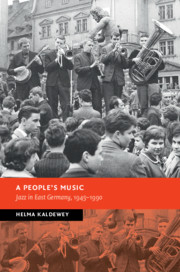Book contents
- A People’s Music
- New Studies in European History
- A People’s Music
- Copyright page
- Contents
- Figures
- Preface
- Chronology
- Abbreviations
- Chapter 1 Jazz in Weimar and Nazi Germany, 1918–1945
- Chapter 2 Jazz in the Soviet Zone, 1945–1949
- Chapter 3 Jazz in the Founding Years of the GDR, 1949–1961
- Chapter 4 Jazz Behind the Wall, 1961–1971
- Chapter 5 The Rise of New Jazz, 1971–1979
- Chapter 6 “A National Treasure”: Jazz Made in the GDR, 1980–1990
- Archival Sources
- Appendix
- Bibliography
- Index
Chapter 2 - Jazz in the Soviet Zone, 1945–1949
Published online by Cambridge University Press: 02 December 2019
- A People’s Music
- New Studies in European History
- A People’s Music
- Copyright page
- Contents
- Figures
- Preface
- Chronology
- Abbreviations
- Chapter 1 Jazz in Weimar and Nazi Germany, 1918–1945
- Chapter 2 Jazz in the Soviet Zone, 1945–1949
- Chapter 3 Jazz in the Founding Years of the GDR, 1949–1961
- Chapter 4 Jazz Behind the Wall, 1961–1971
- Chapter 5 The Rise of New Jazz, 1971–1979
- Chapter 6 “A National Treasure”: Jazz Made in the GDR, 1980–1990
- Archival Sources
- Appendix
- Bibliography
- Index
Summary
Having laid the groundwork for debates about jazz reception in Germany in ,explores jazz in the years of immediate postwar occupation in Germany: from the fall of the regime in 1945 to the founding of the GDR in 1949. During these years, Berlin, the former Nazi capital, served as the epicenter for the formerly Allied occupying powers to engage in ideological battle. During this time, both Soviet and Western allies employed culture, music, and jazz as key tools of the postwar rebuilding effort, with each side using jazz as a political tool to sway audiences toward democratic or socialist ideals. This chapter details the prominence Soviet policymakers assigned to music of African-American descent, recruiting it for propagandistic purposes, and shows how jazz served as entertainment for troops in the Western sectors. Charting the political developments that led to the creation of the GDR in 1949, this chapter further explores the personal experiences of German jazz fans in the late 1940s, whose experiences offer key accounts of racial segregation in the American sectors alongside the impact of Soviet propaganda of the time.
Keywords
- Type
- Chapter
- Information
- A People's MusicJazz in East Germany, 1945–1990, pp. 27 - 74Publisher: Cambridge University PressPrint publication year: 2019

